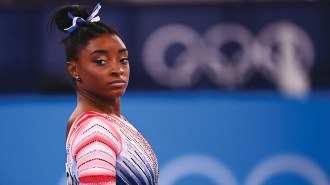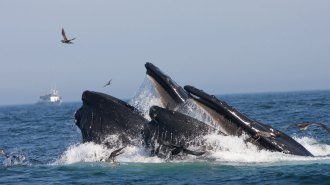Search Results
Examining bias through fossils
Students will learn about early evidence for human evolution, discuss how interpretations of data can be influenced by scientists’ biases and develop a framework for analyzing the physical features of hominin fossils.

Mental Gymnastics
In this guide, students will learn about psychological tools that are helping elite athletes in competitions and everyday life, analyze data visualizations and discuss how the psychological tools might be applied to students' own lives.
Grappling with graphs and other data visualizations
Students will discuss the uses of data visualizations, analyze visualizations from a Science News article, and think about how psychological tools used by elite athletes might benefit their own lives.
Being mindful of mental health
Students will answer questions about the online Science News article “How mindfulness-based training can give elite athletes a mental edge,” which explores new research into psychological tools to improve mental health. A version of the article, “Mental gymnastics,” appears in the January 29, 2022 issue of Science News.

Wildfires May Boost Urban Ozone Levels
In this guide, students will explore chemical interactions within wildfire smoke and how urban air pollution can influence the reactions.
Chemistry of wildfire smoke
Students will answer questions about the online Science News article “Wildfire smoke may ramp up toxic ozone production in cities,” which explores new research into the interactions between wildfire smoke and air pollution in cities. A version of the article, “Wildfires may boost urban ozone levels,” appears in the January 15, 2022 issue of Science News.
Where there’s smoke, there’s science
Students will discuss the composition and properties of air and wildfire smoke, and explore how substances in smoke react to ramp up a certain type of air pollution.

Camera Captures Physics in a Snap
In this guide, students will learn about an experiment inspired by the movie Avengers: Infinity War that investigates the role of friction in a successful finger snap. Students will then apply their scientific knowledge to assess scientific accuracy in movies and other media.
Science in a snap
Students will answer questions about the online Science News article “New high-speed video reveals the physics of a finger snap,” which details scientists’ exploration of the friction required for finger snapping. A version of the article, “Camera captures physics in a snap,” appears in the December 18, 2021 & January 1, 2022 issue of Science News.
Science on screen
Students will discuss the physics of finger snapping and apply their scientific knowledge to think critically about the scientific accuracy of movies and online demonstrations.
Thinking through climate solutions
Students will research how climate change affects a nonhuman species, propose science-based solutions that might lessen the impact of climate change on the species and create an infographic to share with the class.

Whales Eat More Than We Thought
In this guide, students will learn how scientists estimated the food intake of certain whale species and discuss nutrient cycling and conservation of matter within ecosystems.